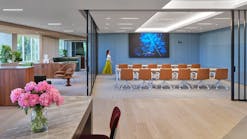Signify CEO cites renewed interest in energy efficiency amid recession (UPDATED)
As economists debate whether the world has tipped into recession, the CEO of the world’s largest lighting company clearly believes it has. But with part of the problem being soaring energy prices, Signify boss Eric Rondolat sees a revitalized interest in efficient LEDs, spelling top-line growth.
“We are facing a recession at this point in time,” Rondolat told one analyst who had inquired about the prospects for growth during a second-quarter financial results call last week. “What we don’t know is the magnitude of that recession.”
While no one can accurately predict exactly what will happen in geopolitics and the global economy, Rondolat is certain about the current mix of business within Signify: Sales volumes are down in the company’s consumer division — known as “Digital Products” — but are well poised for growth in the commercial division — “Digital Solutions.”
The strong outlook in the commercial sector including offices, schools, factories, warehouses, outdoor public spaces, and so on relates to the money that end users save using LEDs as opposed to conventional lighting, and to the extra savings accrued when they connect LED luminaires into smart control systems.
Payback time
Energy savings is by no means a new story in the LED narrative, but it is now an even more compelling one given the rampant escalation of fossil fuel prices.
“We see a renewed traction on energy-efficient lighting, and also a renewed traction on ‘connected’ as it brings additional energy savings,” Rondolat said.
Asked whether there is now a notable shortening of payback periods for LED users, Rondolat said the returns on investment vary depending on business segments, countries, and regional energy prices.
“In some segment applications where the return on investment was three years, it has come down to one, so it’s quite substantial,” he noted.
Signify strengthened its energy-efficiency offerings in the second quarter ending June 30 with a new LED tube that Rondolat said is 44% more efficient than existing LED tubes. The company formally announced the product today. The new Philips MASTER LEDtube UE comes about a year after Signify introduced four “ultraefficient” lamps which provide at least a 60% leap in energy efficiency over existing Signify or other brand LED lamps.
The “UE” (ultraefficient) family meets new EU requirements for “A-class” eco labeling, Signify said.
Energy prices are a big part of the current global inflationary environment, which, while presenting plenty of business opportunity for Signify, has also cut markedly into the company’s profit margins.
Illusion of consumer growth
As LEDs Magazine reported earlier this week, overall company revenue for the quarter ended June 30 was €1.84 billion, marking a 5.1% increase in comparable sales over the second quarter of 2021. Still, from a volume perspective some of that growth was an illusion because it came from inflationary price increases, especially in the consumer and conventional segments.
While the company’s net income grew 203% to €248 million, Rondolat chose instead to focus analysts’ attention on “a gross margin decline of 290 basis points, which is quite substantial.” Adjusted EBITA margin tumbled to 9.5% from 10.9%, leading the company to revise its adjusted EBITA margin guidance for the year downward to between 11% and 11.4%, whereas it had been forecasting continued improvement. Adjusted EBITA itself slipped 0.5%, to €174 million from €175 million, while overall EBITA rose 150% to €340 million from €136 million.
“In the second quarter, we continued to deliver top-line growth,” Rondolat said. “This was driven by strong traction of the professional segment, which more than compensated headwinds from the lockdowns in China, the effect of the war in Ukraine on our Eastern European market, and a weaker consumer environment. This top-line increase — achieved despite a challenging comparison base — illustrates our improved profile for growth, fueled by the continuing shift towards connected lighting. At the same time, currency movements and inflationary pressures affected our gross margin and adjusted EBITA, although the impact on the latter was partially compensated by cost management.”
Sales in digital solutions were €1 billion, up from €837 million in the same quarter a year ago, which marked a 24.4% increase, or 11.6% on a comparable basis.
While most of that increase came from volume, the same could not be said for the consumer (“digital products”) and conventional segments.
“We were slightly negative in volume on digital products,” Rondolat said, where he opined that “we see the first signs of the recession.” The sales value increased to €598 million from €553 million a year earlier (up 8%, or 2.6% on a comparable basis); however, the volume was down.
Likewise, a 9.3% second-quarter decline (13.8% on a comparable basis) in conventional (non-LED) product sales to €30 million from €40 million a year ago was worse than it appeared because price increases buoyed it. “Volume is more negative than what it seems,” Rondolat said.
The Signify boss provided interesting insights on the state of the company’s Hue line of smart home lighting. LEDs will report on that separately.
As LEDs noted in our earlier story this week, Signify has also reevaluated the portion of its UV-C product stable aimed at disinfecting surfaces, which had targeted the professional and consumer markets. A Signify spokesperson has since clarified that the "obsolescence" to which Rondolat referred in that report is a partial accounting provision for inventory that may not be sold according to previously anticipated demand, or those products that will take longer to sell, but remain in the company's portfolio. Get the full details in the linked story above.
MARK HALPER is a contributing editor for LEDs Magazine, and an energy, technology, and business journalist ([email protected]).
Updated Aug. 5, 2022 1:45 PM EDT for link to UV-C story with clarification on updates.
For up-to-the-minute LED and SSL updates, follow us on Twitter. You’ll find curated content and commentary, as well as information on industry events, webcasts, and surveys on our LinkedIn page and our Facebook page.

Mark Halper | Contributing Editor, LEDs Magazine, and Business/Energy/Technology Journalist
Mark Halper is a freelance business, technology, and science journalist who covers everything from media moguls to subatomic particles. Halper has written from locations around the world for TIME Magazine, Fortune, Forbes, the New York Times, the Financial Times, the Guardian, CBS, Wired, and many others. A US citizen living in Britain, he cut his journalism teeth cutting and pasting copy for an English-language daily newspaper in Mexico City. Halper has a BA in history from Cornell University.





